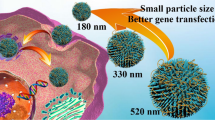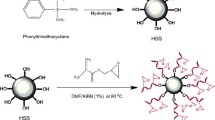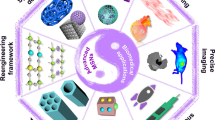Abstract
Until recently, mesoporous silica (MPS) particles have been successfully used in various biomedical applications including drug delivery. In the past decades, the research on MPS shifted sharply to gene delivery owing to its biocompatible, mesoporous structure that allows for loading oligonucleotides, shielding in the bloodstream, and delivering them to patient cells’ cytoplasm to stop cells’ genetic transcription. Until now, researchers faced several unique challenges and MPS, as oligonucleotide vectors, could not reach the clinical stage. In this study, material-related challenges were endeavored to overcome by a combined particle synthesis/oligo-loading strategy. DNA-encapsulated silica/polyethylene glycol (PEG) hybrid xerogels were synthesized at one step, via sol–gel technique. The xerogels were grinded into particles and characterized by X-ray diffraction, scanning electron microscopy, ultraviolet–visible spectroscopy, Fourier transform infrared spectroscopy, and gas adsorption analysis. The results demonstrated that uniform oligo-loaded silica/PEG hybrid xerogels could be synthesized without surface modification. Oligonucleotides were encapsulated inside the whole porous network, rather than attached only to particle surfaces as such in the conventional route. The results showed that PEG incorporation led to formation of monolithic xerogels, which could be grinded into spherical particles (557 ± 110 nm) with well-defined edges. Due to grinding, PEG chains were present both in the interior and on the surface of the particles. 10% PEG incorporation into silica precursor (tetraethyl orthosilicate) increased the resistance of DNA-encapsulated silica against protein degradation. In the overall sol–gel-derived silica/PEG hybrid materials were revealed as potential candidates for gene delivery applications such as RNA interference therapies.




Similar content being viewed by others
References
S.H. Cheng, C.H. Lee, M.C. Chen, J.S. Souris, F.G. Tseng, C.S. Yang, C.Y. Mou, C.T. Chen, and L.W. Lo: Tri-functionalization of mesoporous silica nanoparticles for comprehensive cancer theranostics—the trio of imaging, targeting and therapy. J. Mater. Chem. 20, 6149 (2010).
I. Slowing, B.G. Trewyn, and V.S.Y. Lin: Effect of surface functionalization of MCM-41-type mesoporous silica nanoparticles on the endocytosis by human cancer cells. J. Am. Chem. Soc. 128, 14792 (2006).
X. Shi, Y. Wang, L. Ren, N. Zhao, Y. Gong, and D.A. Wang: Novel mesoporous silica-based antibiotic releasing scaffold for bone repair. Acta Biomater. 5, 1697 (2009).
J. Kim, H.S. Kim, N. Lee, T. Kim, H. Kim, T. Yu, I.C. Song, W.K. Moon, and T. Hyeon: Multifunctional uniform nanoparticles composed of a magnetite nanocrystal core and a mesoporous silica shell for magnetic resonance and fluorescence imaging and for drug delivery. Angew. Chem. 120, 8566 (2008).
W. Stöber, A. Fink, and E. Bohn: Controlled growth of monodisperse silica spheres in the micron size range. J. Colloid Interface Sci. 26, 62 (1968).
T. Yanagisawa, T. Shimizu, K. Kuroda, and C. Kato: The preparation of alkyltriinethylaininonium–kaneinite complexes and their conversion to microporous materials. Bull. Chem. Soc. Jpn. 63, 988 (1990).
M. Vallet-Regí, M. Colilla, I. Izquierdo-Barba, and M. Manzano: Mesoporous silica nanoparticles for drug delivery: Current insights. Molecules 23, 308 (2017).
J. Zhang and K. Cai: Integration of polymers in the pore space of mesoporous nanocarriers for drug delivery. J. Mater. Chem. B 5, 8891 (2017).
H.S. Shin, Y.K. Hwang, and S. Huh: Facile preparation of ultra-large pore mesoporous silica nanoparticles and their application to the encapsulation of large guest molecules. ACS Appl. Mater. Interfaces 6, 1740 (2014).
S. Jafari, H. Derakhshankhah, L. Alaei, A. Fattahi, B.S. Varnamkhasti, and A.A. Saboury: Mesoporous silica nanoparticles for therapeutic/diagnostic applications. Biomed. Pharmacother. 109, 1100 (2019).
T. Xia, M. Kovochich, M. Liong, H. Meng, S. Kabehie, S. George, J.I. Zink, and A.E. Nel: Polyethyleneimine coating enhances the cellular uptake of mesoporous silica nanoparticles and allows safe delivery of siRNA and DNA constructs. ACS Nano 3, 3273 (2009).
F. Torney, B.G. Trewyn, V.S-Y. Lin, and K. Wang: Mesoporous silica nanoparticles deliver DNA and chemicals into plants. Nat. Nanotechnol. 2, 295 (2007).
A. Baeza, M. Colilla, and M. Vallet-Regí: Advances in mesoporous silica nanoparticles for targeted stimuli-responsive drug delivery. Expert Opin. Drug Deliv. 12, 319 (2015).
B.R. Anderson, H. Muramatsu, B.K. Jha, R.H. Silverman, D. Weissman, and K. Kariko: Nucleoside modifications in RNA limit activation of 2′-5′-oligoadenylate synthetase and increase resistance to cleavage by RNase L. Nucleic Acids Res. 39, 9329 (2011).
L. Li, X. Hu, M. Zhang, S. Ma, F. Yu, S. Zhao, N. Liu, Z. Wang, Y. Wang, H. Guan, X. Pan, Y. Gao, Y. Zhang, Y. Liu, Y. Yang, X. Tang, M. Li, C. Liu, Z. Li, and X. Mei: Dual tumor-targeting nanocarrier system for siRNA delivery based on pRNA and modified chitosan. Mol. Ther.-Nucleic Acids 8, 169 (2017).
H-K. Na, M-H. Kim, K. Park, S-R. Ryoo, K.E. Lee, H. Jeon, R. Ryoo, C. Hyeon, and D-H. Min: Efficient functional delivery of siRNA using mesoporous silica nanoparticles with ultralarge pores. Small 8, 1752 (2012).
Q. He, J. Zhang, J. Shi, Z. Zhu, L. Zhang, W. Bu, L. Guo, and Y. Chen: The effect of PEGylation of mesoporous silica nanoparticles on nonspecific binding of serum proteins and cellular responses. Biomaterials 31, 1085 (2010).
M. Shehata Draz, B. Amanda Fang, P. Zhang, Z. Hu, S. Gu, K.C. Weng, J.W. Gray, and F. Frank Chen: Nanoparticle-mediated systemic delivery of siRNA for treatment of cancers and viral infections. Theranostics 4, 872 (2014).
M. Wang, X. Li, Y. Ma, and H. Gu: Endosomal escape kinetics of mesoporous silica-based system for efficient siRNA delivery. Int. J. Pharm. 448, 51 (2013).
D. Kapusuz and C. Durucan: Synthesis of DNA-encapsulated silica elaborated by sol–gel routes. J. Mater. Res. 28, 175 (2013).
D. Kapusuz and C. Durucan: Exploring encapsulation mechanism of DNA and mononucleotides in sol–gel derived silica. J. Biomater. Appl. 32, 114 (2017).
C.J. Brinker and G.W. Scherer: Sol–Gel Science: The Physics and Chemistry of Sol–Gel Processing (Academic Press, Boston, 1990).
R.B. Bhatia, C.J. Brinker, A.K. Gupta, and A.K. Singh: Aqueous sol–gel process for protein encapsulation. Chem. Mater. 12, 2434 (2000).
A.C. Pierre: The sol–gel encapsulation of enzymes. Biocatal. Biotransform. 22, 145 (2004).
E. Reátegui, L. Kasinkas, K. Kniesz, M.A. Lefebvre, and A. Aksan: Silica–PEG gel immobilization of mammalian cells. J. Mater. Chem. B 2, 7440 (2014).
K.D. Kwon, V. Vadillo-Rodriguez, B.E. Logan, and J.D. Kubicki: Interactions of biopolymers with silica surfaces: Force measurements and electronic structure calculation studies. Geochim. Cosmochim. Acta 70, 3803 (2006).
M. Fujiwara, F. Yamamoto, K. Okamoto, K. Shiokawa, and R. Nomura: Adsorption of duplex DNA on mesoporous silicas: Possibility of inclusion of DNA into their mesopores. Anal. Chem. 77, 8138 (2005).
S. Sharma, R.W. Johnson, and T.A. Desai: XPS and AFM analysis of antifouling PEG interfaces for microfabricated silicon biosensors. Biosens. Bioelectron. 20, 227 (2004).
T. Gross, M. Ramm, H. Sonntag, W. Unger, H.M. Weijers, and E.H. Adem: An XPS analysis of different SiO2 modifications employing a C 1s as well as an Au 4f7/2 static charge reference. Surf. Interface Anal. 18, 59 (1992).
D.A. Stephenson and N.J. Binkowski: X-ray photoelectron spectroscopy of silica in theory and experiment. J. Non-Cryst. Solids 22, 399 (1976).
A. Beganskienė, A. Beganskienė, V. Sirutkaitis, M. Kurtinaitienė, R. Juškėnas, and A. Kareiva: FTIR, TEM, and NMR investigations of Stöber silica nanoparticles. Mater. Sci. Eng. C 10, 287 (2004).
M.C. Matos, L.M. Ilharco, and R.M. Almeida: The evolution of TEOS to silica gel and glass by vibrational spectroscopy. J. Non-Cryst. Solids 147–148, 232 (1992).
B.B.R.K. Nariyal and P. Kothari: FTIR measurements of SiO2 glass prepared by sol–gel technique. Chem. Sci. Trans. 3, 1064 (2014).
F. Rubio, J. Rubio, and J.L. Oteo: A FT-IR study of the hydrolysis of tetraethylorthosilicate (TEOS). Spectrosc. Lett. 31, 199 (1998).
A. Akbari, R. Yegani, and B. Pourabbas: Synthesis of poly(ethylene glycol) (PEG) grafted silica nanoparticles with a minimum adhesion of proteins via one-pot one-step method. Colloids Surf., A 484, 206 (2015).
P-Y. Chu and D.E. Clark: Infrared spectroscopy of silica sols–effects of water concentration, catalyst, and aging. Spectrosc. Lett. 25, 201 (1992).
P. Lesot, S. Chapuis, J.P. Bayle, J. Rault, E. Lafontaine, A. Campero, and P. Judeinstein: Structural–dynamical relationship in silica PEG hybrid gels. J. Mater. Chem. 8, 147 (1998).
M.S.W. Vong, N. Bazin, and P.A. Sermon: Chemical modification of silica gels. J. Sol–Gel Sci. Technol. 8, 499 (1997).
Z. Alothman: A Review: Fundamental aspects of silicate mesoporous materials. Materials (Basel) 5, 2874 (2012).
S.T. Saito, G. Silva, C. Pungartnik, and M. Brendel: Study of DNA-emodin interaction by FTIR and UV-vis spectroscopy. J. Photochem. Photobiol., B 111, 59 (2012).
B. Darvishi, L. Farahmand, and K. Majidzadeh-A: Stimuli-responsive mesoporous silica NPs as non-viral dual siRNA/chemotherapy carriers for triple negative breast cancer. Mol. Ther.-Nucleic Acids 7, 164 (2017).
J. Meissner, A. Prause, B. Bharti, and G.H. Findenegg: Characterization of protein adsorption onto silica nanoparticles: Influence of pH and ionic strength. Colloid Polym. Sci. 293, 3381 (2015).
A. Lazaro, N. Vilanova, L.D. Barreto Torres, G. Resoort, I.K. Voets, and H.J.H. Brouwers: Synthesis, polymerization, and assembly of nanosilica particles below the isoelectric point. Langmuir 33, 14618 (2017).
H.P. Erickson: Size and shape of protein molecules at the nanometer level determined by sedimentation, gel filtration, and electron microscopy. Biol. Proced. Online 11, 32 (2009).
A.B. Fuertes, P. Valle-Vigón, and M. Sevilla: Synthesis of colloidal silica nanoparticles of a tunable mesopore size and their application to the adsorption of biomolecules. J. Colloid Interface Sci. 349, 173 (2010).
C.D. Conover, R. Linberg, K.L. Shum, and R.G.L. Shorr: The ability of polyethylene glycol conjugated bovine hemoglobin (PEG-Hb) to adequately deliver oxygen in both exchange transfusion and top-loaded rat models. Artif. Cells, Blood Substitutes, Biotechnol. 27, 93 (1999).
D.I. Svergun, F. Ekströ, K.D. Vandegriff, A. Malavalli, D.A. Baker, C. Nilsson, and R.M. Winslow: Solution structure of poly(ethylene) glycol-conjugated hemoglobin revealed by small-angle X-ray scattering: Implications for a new oxygen therapeutic. Biophys. J. 94, 173 (2008).
J. Lipfert, S. Doniach, R. Das, and D. Herschlag: Understanding nucleic acid–ion interactions. Annu. Rev. Biochem. 83, 813 (2014).
Hydrophobicity, Polarity and Charge of Hemoglobin (2018): Available at: http://bioinformatics.org/jmol-tutorials/jtat/hemoglobin/5phob/chapter.htm (accessed September 20, 2019).
Q. He, Z. Zhang, F. Gao, Y. Li, and J. Shi: In vivo biodistribution and urinary excretion of mesoporous silica nanoparticles: Effects of particle size and PEGylation. Small 7, 271 (2011).
Acknowledgment
The author acknowledges Gaziantep University for funding the research under the project No. RM. 16.01.
Author information
Authors and Affiliations
Corresponding author
Rights and permissions
About this article
Cite this article
Kapusuz, D. Sol–gel derived silica/polyethylene glycol hybrids as potential oligonucleotide vectors. Journal of Materials Research 34, 3787–3797 (2019). https://doi.org/10.1557/jmr.2019.341
Received:
Accepted:
Published:
Issue Date:
DOI: https://doi.org/10.1557/jmr.2019.341






